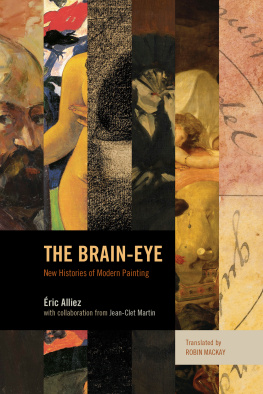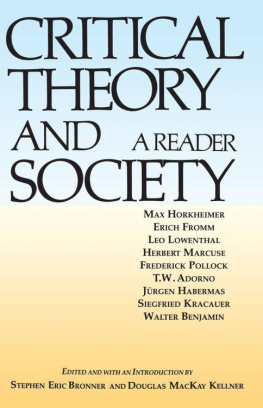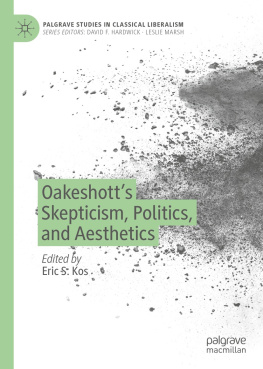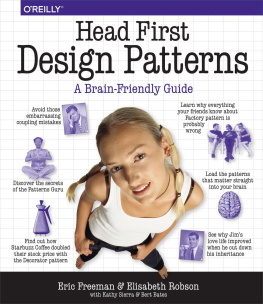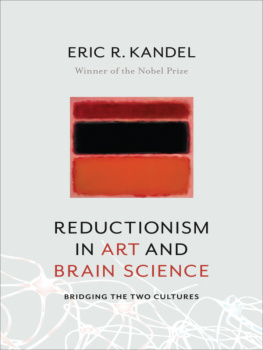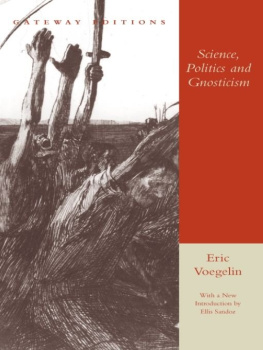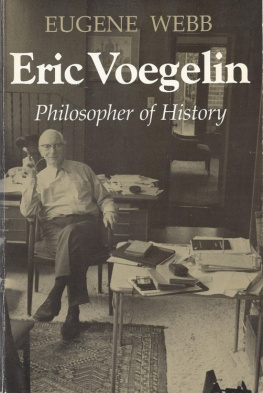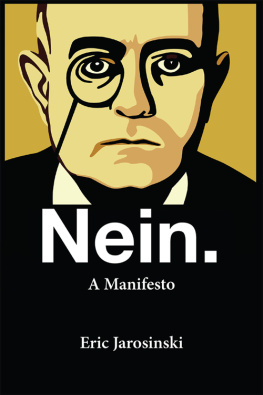Alliez Éric - The brain-eye: new histories of modern painting
Here you can read online Alliez Éric - The brain-eye: new histories of modern painting full text of the book (entire story) in english for free. Download pdf and epub, get meaning, cover and reviews about this ebook. City: London;New York, year: 2016, publisher: Rowman & Littlefield International, genre: Science. Description of the work, (preface) as well as reviews are available. Best literature library LitArk.com created for fans of good reading and offers a wide selection of genres:
Romance novel
Science fiction
Adventure
Detective
Science
History
Home and family
Prose
Art
Politics
Computer
Non-fiction
Religion
Business
Children
Humor
Choose a favorite category and find really read worthwhile books. Enjoy immersion in the world of imagination, feel the emotions of the characters or learn something new for yourself, make an fascinating discovery.
- Book:The brain-eye: new histories of modern painting
- Author:
- Publisher:Rowman & Littlefield International
- Genre:
- Year:2016
- City:London;New York
- Rating:4 / 5
- Favourites:Add to favourites
- Your mark:
- 80
- 1
- 2
- 3
- 4
- 5
The brain-eye: new histories of modern painting: summary, description and annotation
We offer to read an annotation, description, summary or preface (depends on what the author of the book "The brain-eye: new histories of modern painting" wrote himself). If you haven't found the necessary information about the book — write in the comments, we will try to find it.
The brain-eye: new histories of modern painting — read online for free the complete book (whole text) full work
Below is the text of the book, divided by pages. System saving the place of the last page read, allows you to conveniently read the book "The brain-eye: new histories of modern painting" online for free, without having to search again every time where you left off. Put a bookmark, and you can go to the page where you finished reading at any time.
Font size:
Interval:
Bookmark:
The Brain-Eye
The Brain-Eye
New Histories of Modern Painting
ric Alliez
With collaboration from Jean-Clet Martin
Translated by Robin Mackay

London New York
Cover art credits:
Portrait de lartiste au fond rose / Paul Czanne (18391906) / RMN - Grand Palais / Patrice Schmidt / Muse dOrsay
Te nave nave fanua (1892) / Paul Gauguin / Ohara Museum of Art
La Voilette / Georges Seurat (18591891) / RMN - Grand Palais / Thierry Le Mage / Muse dOrsay
Berthe Morisot lventail / Berthe Morisot (18411895) and Edouard Manet (18321883) / RMN - Grand Palais / Herv Lewandowski / Muse dOrsay
Mort de Sardanapale / Eugne Delacroix (17981863) / RMN - Grand Palais / Herv Lewandowski / Muse du Louvre
Johann Wolfgang von Goethe: Farbenkreis zur Symbolisierung des menschlichen Geistes- und Seelenlebens. 1809. Aquarellierte Federzeichnung. Inv. Nr. III-14047. Freies Deutsches Hochstift / Frankfurter Goethe-Museum, Foto: David Hall
Published by Rowman & Littlefield International, Ltd.
Unit A, Whitacre Mews, 26-34 Stannary Street, London SE11 4AB
www.rowmaninternational.com
Rowman & Littlefield International, Ltd. is an affiliate of Rowman & Littlefield
4501 Forbes Boulevard, Suite 200, Lanham, Maryland 20706, USA
With additional offices in Boulder, New York, Toronto (Canada), and Plymouth (UK)
www.rowman.com
This translation copyright 2016 Rowman & Littlefield International
Originally published in French as Loeil-cerveau. Nouvelles histoires de la peinture moderne
Copyright Librairie Philosophique J. Vrin, Paris, 2007.
http://www.vrin.fr
All rights reserved . No part of this book may be reproduced in any form or by any electronic or mechanical means, including information storage and retrieval systems, without written permission from the publisher, except by a reviewer who may quote passages in a review.
British Library Cataloguing in Publication Data
A catalogue record for this book is available from the British Library
ISBN: HB 978-1-78348-067-8
PB 978-1-78348-068-5
Library of Congress Cataloging-in-Publication Data
Alliez, ric, author.
[Oeil-cerveau. English]
The brain-eye : new histories of modern painting / ric Alliez ; With collaboration from Jean-Clet Martin ; Translated by Robin Mackay.
pages cm
Includes bibliographical references and index.
ISBN 978-1-78348-067-8 (cloth : alk. paper)ISBN 978-1-78348-068-5 (pbk. : alk. paper)ISBN 978-1-78348-069-2 (electronic)
1. Painting, European19th century. 2. Painting, ModernPhilosophy. I. Martin, Jean-Clet. II. Mackay, Robin (Philosopher), translator. III. Title.
ND457.A4513 2016
759.05dc23 2015030311
 The paper used in this publication meets the minimum requirements of American National Standard for Information SciencesPermanence of Paper for Printed Library Materials, ANSI/NISO Z39.48-1992.
The paper used in this publication meets the minimum requirements of American National Standard for Information SciencesPermanence of Paper for Printed Library Materials, ANSI/NISO Z39.48-1992.
Printed in the United States of America
Contents
A major work ofand beyondphilosophical aesthetics, a dense and perplexing multiplicity of a text, but one infused by an irrepressible and compelling lan, at once a set of discontinuous plateaus which the reader must learn to assemble and a series of lyrical sallies of cumulative intensity and momentum, The Brain-Eye conducts its rediscovery of the plural powers of painting through an experiment in writing and an audacious (de)construction of the book-form. In a manner that recalls Gilles Deleuzes refusal of the history of philosophy as a teleological progression with a common finality, and his insistence instead on a history of problems (in the entirely positive sense he gives to the term), the chapters that make up The Brain-Eye set out to overcome a set of obstacles erected by art history and the philosophy of art so as to arrive at an understanding of the singular problems that trouble and motivate protagonists whom we once imagined we knew, as, between the practice of painting and the discursive conceptualisation of the new modes of seeing it engenders, they bring to the surface of painting the materiality of the visual. Patiently reconstructing the itineraries of these singular voyages, negotiating the byways of received opinion, critical commentary, and the never straightforward relation between painters writings and sayings and their practice, ric Alliez gives us a series of case studies, each of which can be read as a self-contained history but which are raised to their highest power when one perceives, braided together across them, a set of transversal threads that make of the book a whole that greatly exceeds its parts.
This textual dispositif harbours a writing machine that is as meticulous in its employment of a formidable corpus of secondary materials as it is intransigent in its exuberant refusal to submit writing to the demands of communication by collapsing its perplexities, resonances, and reiterations into a clear propositional form (as if the thickness of writing was merely the result of an obdurate refusal to make things explicit, rather than the necessary prerequisite of a real engagement with matters that overflow a strictly discursive frame). This is, therefore, a book that leaves the reader no choice but to participate actively in a construction that is laid out precisely and delicately, touch by touch, in order to realise a whole whose finish is that of an all-over effect rather than a transparent encapsulation: a definitively incomplete whole which, by means of its conceptual warp and weft, continually maintains in tension a set of forces that it falls to the reader to negotiate.
In staging these histories which operate a mutual complication of philosophical aesthetics and art history, Alliez brings before us a cast of characters whose aspect is equally unfamiliar to both disciplinesDelacroix, the Turk; Seurat, the extraterrestrial automaton; a serialist Manet, a logician Czanne glaring at us with the enucleated eyes of a skull.... In the process, he punctures biographical legend and shatters critical commonplaces (Delacroixs Orient is absolutely determinative, yet the outside it brings to light is hardly that of the orientalist imaginary; Czannes dedication to nature and his provenal blood only serve to obscure the rigour of his endless labour on the motif; Gauguin is a potter even when hes a painter, and his exoticism pertains to a land more foreign yet than the luxuriant tropics, a new earth...). As evidenced by the precise analyses of selected paintings that serve as focal points for each of the chapters (and which will serve the reader as the most potent proof of the penetrating force of their arguments when consulted withat leasta reproduction to hand), these audacious figures are the direct result of the authors decision to attend exclusively to what is realised in the practice of painting itself or rather, practices plural.
For, upon entering into this open-air theatre, we must also abandon a linear narrative of the history of artthat of a chain of successors who break with the past and advance in the direction of some ulterior finalityin favour of an untimely and imageless history of researcher-painters who, between them but never in unison, project, construct, and hallucinate , from the middle ( par le milieu ), the virtual field of forces that is modern painting. To extract these kernels of painter-thought, Alliez patiently peels off the petrified carapace of historical clich, hagiographic doggerel, and indurate myth, allowing us to see the paintings once more, attending to the movement of thought deposited in them, and registering the tension implied by the continual struggle of painters to say what they do, or at least to distance themselves from what is said of them and on their behalf. As these overcodings fall away, what is revealed is the style of each subject: style as a habitus , a culture unto itself, at once overdetermined by a multiplicity of influences and intuitions and resolute in the obsessive pursuit of its singular problem. These disparate microcultures, in their turn, are over the course of the book patiently worked into a broader vision of the modernity of painting, with the plateaus coming together and interlocking at unexpected moments and unanticipated angles. Thus, The Brain-Eye confronts us with a punctual set of historical events, observations, causes and effects, surface formations rebarbative to any kind of dialectical or narrative reconciliation, while at the same time indicating the continuity of a subterranean plane of consistency whose unearthing will require an unprecedented effort of thought.
Next pageFont size:
Interval:
Bookmark:
Similar books «The brain-eye: new histories of modern painting»
Look at similar books to The brain-eye: new histories of modern painting. We have selected literature similar in name and meaning in the hope of providing readers with more options to find new, interesting, not yet read works.
Discussion, reviews of the book The brain-eye: new histories of modern painting and just readers' own opinions. Leave your comments, write what you think about the work, its meaning or the main characters. Specify what exactly you liked and what you didn't like, and why you think so.

